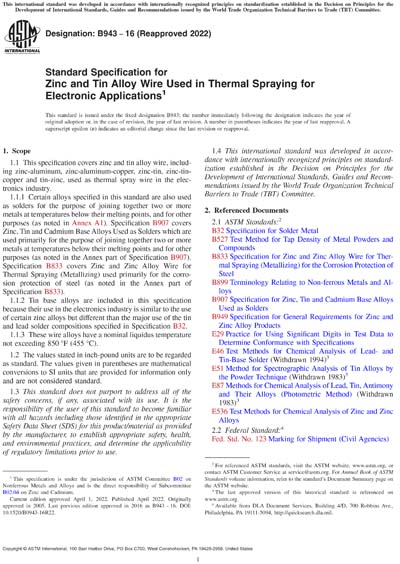Most recent
ASTM B943-16(2022)
Standard Specification for Zinc and Tin Alloy Wire Used in Thermal Spraying for Electronic Applications
1.1This specification covers zinc and tin alloy wire, including zinc-aluminum, zinc-aluminum-copper, zinc-tin, zinc-tin-copper and tin-zinc, used as thermal spray wire in the electronics industry.
1.1.1Certain alloys specified in this standard are also used as solders for the purpose of joining together two or more metals at temperatures below their melting points, and for other purposes (as noted in Annex A1). Specification B907 covers Zinc, Tin and Cadmium Base Alloys Used as Solders which are used primarily for the purpose of joining together two or more metals at temperatures below their melting points and for other purposes (as noted in the Annex part of Specification B907). Specification B833 covers Zinc and Zinc Alloy Wire for Thermal Spraying (Metallizing) used primarily for the corrosion protection of steel (as noted in the Annex part of Specification B833).
1.1.2Tin base alloys are included in this specification because their use in the electronics industry is similar to the use of certain zinc alloys but different than the major use of the tin and lead solder compositions specified in Specification B32.
1.1.3These wire alloys have a nominal liquidus temperature not exceeding 850 °F (455 °C).
1.2The values stated in inch-pound units are to be regarded as standard. The values given in parentheses are mathematical conversions to SI units that are provided for information only and are not considered standard.
1.3This standard does not purport to address all of the safety concerns, if any, associated with its use. It is the responsibility of the user of this standard to become familiar with all hazards including those identified in the appropriate Safety Data Sheet (SDS) for this product/material as provided by the manufacturer, to establish appropriate safety, health, and environmental practices, and determine the applicability of regulatory limitations prior to use.
1.4This international standard was developed in accordance with internationally recognized principles on standardization established in the Decision on Principles for the Development of International Standards, Guides and Recommendations issued by the World Trade Organization Technical Barriers to Trade (TBT) Committee.
Content Provider
ASTM International [astm]






